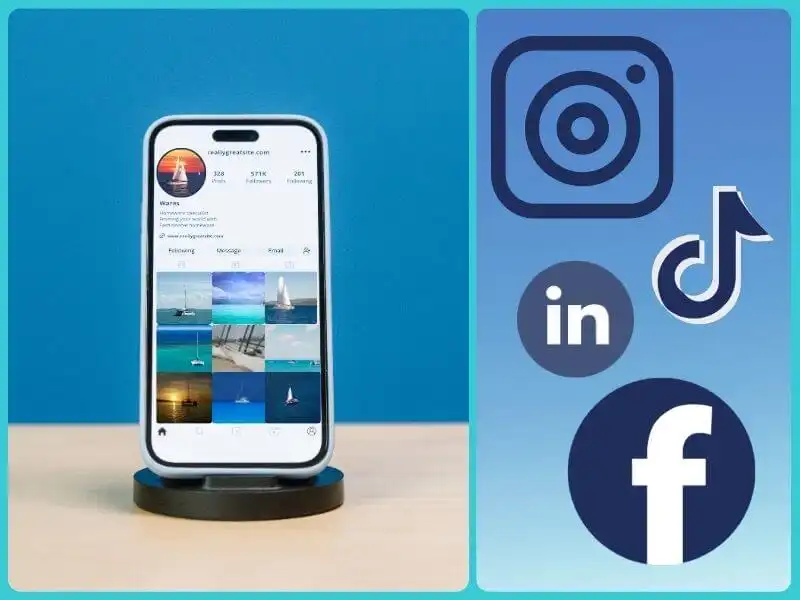
- 05.05.2025.
- News, Social media
When you know where you're going – it's easier to get there. It's the same with social media. Without a plan, without content, and with posts that look like you don't care – it's hard to stand out in the overwhelming flood of content that social media churns out daily. Here's a guide with 10 tips to make sure your social media profiles don’t look like they’re stuck in 1999.
Today, guests are looking for more than a clean cabin and a good price. They want emotions. They want security.
And most often – they look for you on social media. Social media has become the extended arm of word-of-mouth recommendations, except now everyone hears them – and sees them.
In nautical tourism, online presence can determine who gets an inquiry – and who doesn’t.
And while everyone knows that "something should be posted", few actually know what that means in practice. That's why we've put together this guide with 10 tips for successfully managing social media, tailored to the reality of the Croatian yacht charter industry.
1. A profile that looks “alive”
On social media, consistency matters more than you think. A profile with no posts for months gives the impression that you’re not making an effort – or that your company is no longer operating.
And the point isn’t just to post something, but to have a regular rhythm and schedule. You don’t need to post every day, but once or twice a week is more than enough to keep your audience engaged.
And if you throw in at least one educational video or visually attractive post per week, you’ll attract more interest, comments, and inquiries. Definitely more than if you only post during the season and then nothing until the next one.

2. Don’t put everything in one basket – each platform has its role
Instagram is for emotions, Facebook for the local audience and returning guests, TikTok for the younger adventure-seeking crowd. LinkedIn is great for business topics, partners, and even recruiting staff.
But don’t just copy and paste everything everywhere – adjust the tone, format, and message.
If you share sunset pictures/videos on Instagram, and useful travel tips on Facebook, you’re covering a broader audience without losing your identity.
3. Don’t just talk about yourself
Nobody likes someone who constantly talks only about themselves. Social media (and your followers) crave balance: show off the local beauty, interesting spots, festivals, and other events – even content from others that’s useful for your guests.
If you share local recipes, regatta clips, and fun facts from the marina, you’ll connect better with your audience than if you only post boat photos already visible in booking systems and “early booking 20%”.

4. Stories sell better than price lists
Guests want to almost feel, through social media, what their trip would be like if they booked with you – not your Excel spreadsheet.
Tell them what a day on the boat looks like, what the skipper does, how to anchor in sudden bad weather, or why someone came back for the third year in a row. People remember stories.
A post where a skipper recalls how guests caught their first fish and grilled it on board that evening will attract more attention than any promotional post.
5. Photos that “smell” like the sea, not (free) stock
Audiences can tell the difference between real and fake. Simple but authentic phone snaps that show a real moment – breakfast in the salon, first jump into the sea, a relaxed skipper – have more impact than professional but generic images.
A post with an unfiltered photo of breakfast on the deck – with a cup of coffee, the creaking of ropes, and a sea view – more often sparks comments and saves than a perfectly edited drone shot of the boat.

6. Involve your team – from marina to office
Your followers are definitely curious about how your company operates and who’s behind it. People just love seeing other people. Show the real people behind your yacht charter – skippers, hostesses, technicians, back office staff... That builds trust and shows professionalism.
A series like “meet our team” can be a great content idea between seasons.
7. Respond like a person, not a robot
Messages and comments are the first signs of interest. Responding to them is never a waste of time. In fact, you’re building a relationship with your audience and showing that you care.
A quick, friendly, and specific reply makes a big difference. Generic answers or just liking a comment without a personal touch... Just don’t.
A profile that replies to a comment/message within a few hours is more likely to move the conversation to official channels like email.

8. A plan without a plan is a waste of time (and money)
Have a basic content plan – it saves you time, reduces stress, and gives you more control.
You don’t even need fancy tools to start (though tools do help). At the beginning, a simple Google Doc or spreadsheet will do. The key is to know what you're posting each week and why.
With a weekly posting schedule and pre-prepared photos and videos, you’ll gain consistency and avoid posting on a whim.
9. Tell guests what to do – and they’ll actually do it
A call to action (CTA) doesn’t have to be pushy.
Ask your audience for their opinion, invite them to comment on their favorite route, or share their post. People like to be invited to participate.
A post asking “What’s your tip for first-time sailors?” will definitely generate a lot of comments and engagement.
10. It’s not all about the likes (but they’re not useless either)
Track your stats to see what resonates with your audience.
You don’t need to analyze everything, but do keep an eye on which posts get the most engagement. That tells you where to go next.
If you notice that posts about your team’s daily work and behind-the-scenes content get more attention, use more of that kind of content.

People still seek authenticity and a good story
Social media wants your honesty.
The Croatian yacht charter industry has an incredible wealth of content, interesting people, and stories worth telling.
Instead of trying to please the algorithm, try this: be interesting to real people.
See your social media management and content as a long-term investment in your guests’ trust, your reputation, and direct communication. And as we all know – in the high season, that’s worth more than a thousand brochures.
If it feels like your social media is stuck halfway, or you simply want to get more out of what you’re already doing – we’re here. Need a profile review, content guidelines, or campaign support? Contact us directly through our contact form or email us at info@charter.hr.
Once a week, we send a roundup of the best content, top tips, and useful ideas for those who truly work in yacht charter.
Sign up for our newsletter – it takes a few seconds, and it can save you hours.
Categories of trends
- News
- Sale
- Marketing
- SEO
- Web design
- Social media
- Technology
- Regulations
- Management
- Education
- Finances
- User experience
Newsletter
Sign up for the newsletter and receive the latest trends and tips straight to your inbox





